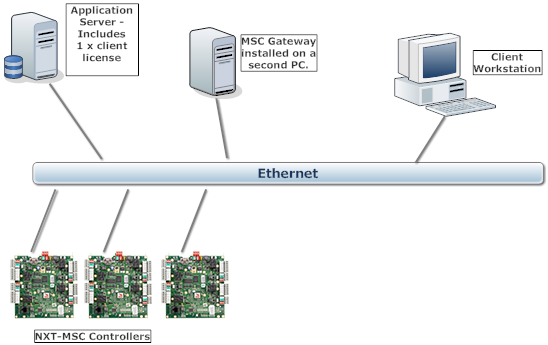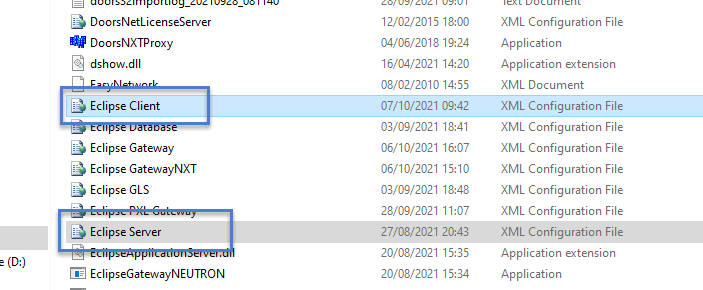Doors.NET - Application Server
Application Server to Clients and Gateways
The Application Server is the heart of the Doors.NET system. It is an asynchronous, TCP socket server that accepts connections from both the gateways and clients and provides a generic transport mechanism for any .NET class object, collection of those objects, or file.
This core component communicates with the SQL database, client workstations and communication gateways that in turn communicate with the field hardware. At least one Application Server is required per system and only one Application Server can be installed on a PC.
Both clients and gateways can be configured for DHCP as the Application Server tracks each incoming connection by its current IP address. Note that Clients send commands to the gateways through the Application Server. Clients and gateways do not communicate directly with each other, as all communications must go through the Application Server.
The default TCP port that a client uses is port 11000. The default can be changed via XML configuration files, but must be done so at both the Application Server and the client. The standard version of the Doors.NET software comes with 1 client connection enabled, but this can be expanded with the purchase of additional client connections (enabled in your license).
Important Note: The machine where the Application Server is installed must be set to a static IP address. If the SQL Server being used by the Application Server is located on a different machine, then that machine must also have a static IP address.
The example below is a typical basic Doors.NET system with MSC hardware. For systems with a single gateway you can, of course run the Application Server and the Gateway on a single PC.

For systems with a single gateway you can run the Application Server and the Gateway on a single PC or they can both reside on the same host PC
This core component communicates with the SQL database, client workstations and communication gateways that in turn communicate with the field hardware. At least one Application Server is required per system and only one Application Server can be installed on a PC.
Both clients and gateways can be configured for DHCP as the Application Server tracks each incoming connection by its current IP address. Note that Clients send commands to the gateways through the Application Server. Clients and gateways do not communicate directly with each other, as all communications must go through the Application Server.
The default TCP port that a client uses is port 11000. The default can be changed via XML configuration files, located at C:\Keri\DoorsNET.

This port number change must be done so at both the Application Server and the client. The standard version of the Doors.NET software comes with 1 client connection enabled, but this can be expanded with the purchase of additional client connections (enabled in your license).
Important Note: The machine where the Application Server is installed must be set to a static IP address. If the SQL Server being used by the Application Server is located on a different machine, then that machine must also have a static IP address.
Related Articles
Doors.NET Communication Ports
Doors.NET - Ethernet Communication Ports (PDF) P/N: 01248-001 Rev. A (attached)Doors.NET Troubleshooting Guide
The following guide aims to assist you in troubleshooting and identifying some of the issues that may be encountered when setting up and using the Doors.NET software and supported hardware. Where there are multiple possible causes, the suggested ...Doors.NET - Custom Installation
1.0 Introduction A full installation installs the minimum required components for a single-PC system (the Application Server, hardware gateways, archive service and administrative client). The custom install option is used to install additional ...Doors.NET - Full Installation
1.0 Introduction The Doors.NET software can be downloaded from the www.kerisys.com software downloads section. You can download just the installation file or you can download the entire installation file set (which will allow you to perform the ...Doors.NET Data Sheet
Doors.NET Data Sheet (attached)